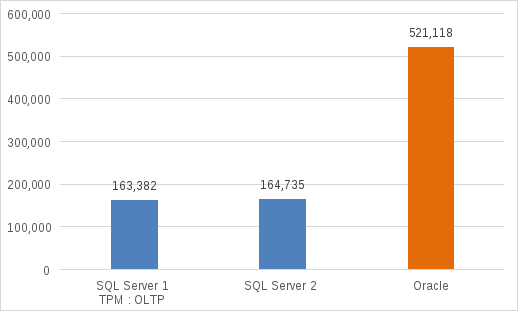Home > Workload Solutions > SQL Server > Guides > Reference Architecture Guide—Consolidate and Simplify Mixed Database Workloads > TPM
TPM
-
In the TPC-C–like order entry benchmark, TPM indicates the total number of transactions per minute for the database. This means TPM includes transactions from the TPC-C–like benchmark and other transactions in the database. For example, TPM includes both commits and rollbacks. TPM is not a metric that we can use to compare database performance because databases implement transaction tracking differently. Because TPM is pulled from memory-based tables in the database, it does not impact the benchmark performance.
The following figure shows the TPM in the baseline OLTP use case test.

Figure 6. TPM of baseline for OLTP databases
Because no other workloads were running on the system, the expectation is that these TPM values for the OLTP SQL Server databases and Oracle database would be the highest achieved. When we added the DSS workload, these TPM values showed a minor drop from these maximum values.
In the DSS use case test, the goal was to determine what impact the DSS workload would have on the TPM metrics for the OLTP databases. The following figure shows the TPM of the baseline with OLTP databases and the DSS workload running in parallel.

Figure 7. TPM of baseline OLTP databases with DSS workload running in parallel
The DSS workload running in parallel with the OLTP databases did have an impact on TPM for both the baseline SQL Server and Oracle databases:
- SQL Server OLTP 1 achieved 152,600 TPM—a difference of 10,782 from the OLTP use case test maximum of 163,382.
- SQL Server OLTP 2 achieved 152,458 TPM—a difference of 12,277 from the OLTP use case test maximum of 164,735.
- Oracle OLTP achieved 456,420 TPM—a difference of 64,698 from the OLTP use case test maximum of 521,118.
Customers need to know if creating a snapshot of a database using PowerMax SnapVX will impact production performance. We ran the snapshot databases with a light OLTP workload using the TPC-C–like benchmark to analyze the impact on the baseline OLTP databases. The following figure shows the TPM results from all three use cases:
- Baseline OLTP workload only
- OLTP + DSS workloads
- OLTP + DSS + snapshot (SNAP) workloads
The figure also shows how the increasing workloads from each incremental use case affected the TPM performance of the baseline OLTP databases.

Figure 8. TPM results with all three use case workloads running in parallel
In the final use case test, adding the snapshot database workload on top of the OLTP and DSS workloads had very little impact on the baseline OLTP TPM performance:
- SQL Server OLTP 1 achieved 157,536 TPM—a difference of 5,846 or 4 percent from the baseline maximum of 163,382.
- SQL Server OLTP 2 achieved 155,197 TPM—a difference of 9,538 or 6 percent from the baseline maximum of 164,735.
- Oracle OLTP achieved 521,118 TPM—equal to the baseline maximum of 521,118.
During this final use case test, the snapshot OLTP databases ran a light TPC-C–like workload and achieved the following TPM levels:
- 12,348 TPM for SQL Server snapshots
- 24,340 TPM for Oracle snapshots
In most mixed workload environments, minor variances in performance occur daily, but the key success factor is overall performance consistency. For example, the Oracle database showed the most significant drop in TPM with the DSS workload running. However, the Oracle database performance in the third test was equal to the performance in the OLTP baseline test. Minor changes in performance are expected, but this reference architecture for mixed workloads demonstrated consistent performance throughout the tests.
